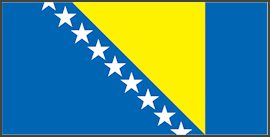Military Budget
 The final and perhaps crowning element in corroborating the fact that the Armed Forces of Bosnia and Herzegovina are a "single military force" will be the establishment of a common Defence Budget for the Armed Forces of Bosnia and Herzegovina. In order to achieve this, it is necessary to meet certain preconditions, as follows: first, full implementation of a Value Added Tax (VAT) for Bosnia and Herzegovina, which will provide significant revenues for the State of Bosnia and Herzegovina and thereby reduce dependence on funding from the budgets of the two entities; and second, political consensus on relevant factors in Bosnia and Herzegovina and the subsequent enactment of appropriate legal regulations on a common defence budget.
The final and perhaps crowning element in corroborating the fact that the Armed Forces of Bosnia and Herzegovina are a "single military force" will be the establishment of a common Defence Budget for the Armed Forces of Bosnia and Herzegovina. In order to achieve this, it is necessary to meet certain preconditions, as follows: first, full implementation of a Value Added Tax (VAT) for Bosnia and Herzegovina, which will provide significant revenues for the State of Bosnia and Herzegovina and thereby reduce dependence on funding from the budgets of the two entities; and second, political consensus on relevant factors in Bosnia and Herzegovina and the subsequent enactment of appropriate legal regulations on a common defence budget.
The defence of Bosnia and Herzegovina requires significant human and material resources; therefore, transparency is very important to the process of defence planning and funding. These two functions, carried out at the State level by the Bosnia and Herzegovina Ministry of Defence, establish the necessary relationships between military strategies, methods to implement those strategies, and the means to obtain the necessary resources. Therefore, information on those issues must be accessible to elected officials and citizens of Bosnia and Herzegovina. The principle of transparency must be applied throughout the entire defence system and it has to be clearly demonstrated that the resources supporting that system are under the control of elected civilian officials.
Defence planning within Bosnia and Herzegovina is a complex process of interrelated elements, beginning with the definition of challenges, goals, missions and resources, and leading to the distribution of resources among defence tasks. The end result of the planning process is a comprehensive and consistent set of plans that express how the Armed Forces of Bosnia and Herzegovina contribute to the security of Bosnia and Herzegovina and its citizens, and how they help to comply with international obligations.
Defence planning is a continuous process of evaluation and decision-making on issues of interest for the state. The process identifies the interests of Bosnia and Herzegovina, challenges and risks to the security of Bosnia and Herzegovina, defence objectives, defence strategy, own forces, friends and allies and - based on all of that - assessment and funding priorities. From this analysis and subsequent decisions, resources are planned, programmed and budgeted to enable the Armed Forces of Bosnia and Herzegovina to respond to the defence challenges of the State of Bosnia and Herzegovina.
The Bosnia and Herzegovina defence system is funded from a budget comprised of three parts: the State budget and two entity budgets. The development and proposal of defence budgets is co-ordinated by the Bosnia and Herzegovina Minister of Defence. The method and procedures for governing this process make up the Bosnia and Herzegovina Common Defence Resource Management System, the major operating component of which is the Planning, Programming, Budgeting, and Execution System (PPBES). The PPBES is a comprehensive management system that connects strategy, operations, and resources. Resources in the defence sector include people, supplies and equipment, facilities, information management, communication capability, transportation, force structure, information, time, and money. The ultimate goal of the Common Defence Resource Management System is to achieve the greatest degree of security at the least cost, while applying scarce defence resources in an efficient and cost effective manner to address those military tasks most critical to the security of the State.
With respect to the Armed Forces, their size has been significantly reduced and restructuring is in progress. Reductions in the size and structure of the Armed Forces shall provide for rationalisation. In March 2004, the Presidency issued a decision approving a plan for General Officer posts within the new structure, which determined a maximum thirteen general officer posts in the Armed Forces of Bosnia and Herzegovina. The highest ranking officer in the Armed Forces of Bosnia and Herzegovina is the Chief of Joint Staff, a Lieutenant-General. In addition, the Presidency directed that General Officers then serving in the Army of the Federation of Bosnia and Herzegovina and the Army of Republika Srpska would not be appointed to General Officer posts in State-level defence institutions and structures. This decision clearly confirmed the orientation of Bosnia and Herzegovina towards new challenges, making way for new ideas and for the implementation of reforms.
The size and structure of the Armed Forces of Bosnia and Herzegovina was established by the Presidency Decision of 24 March 2004, with total of 12,000 professional soldiers, 12,600 conscripts and 60,000 reservists. According to the Decision, the Army of Republika Sprska is authorised 4,000 professional soldiers, 4,200 conscripts, and 20,000 reservists. The Army of the Federation of Bosnia and Herzegovina is authorised 8,000 professional soldiers (5,576 Bosniaks and 2,424 Croats), 8,400 conscripts (6,416 Bosniaks and 1,986 Croats), and 40,000 reservists (28,750 Bosniaks and 11,250 Croats). Conscripts serve their period of conscription in the training structures of the entity armies.

|
NEWSLETTER
|
| Join the GlobalSecurity.org mailing list |
|
|
|

